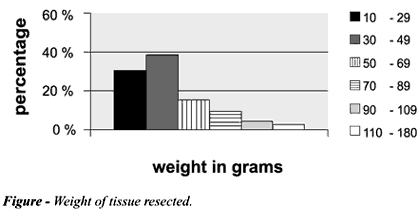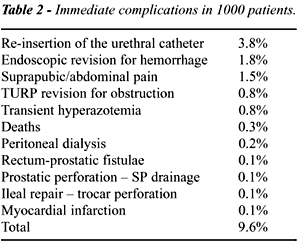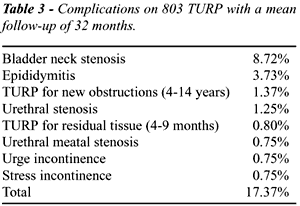TRANSURETHRAL PROSTATECTOMY: REVIEW OF 1,000 PATIENTS USING DISTILLED WATER AS IRRIGATING FLUID AND THE SUPRAPUBIC SHUNT
RONALDO A.S. ZULIAN,
KLEBER E. PIEDADE, ROBERTO R. BRITO,
HAMILTON J. BORGES, LUIS A.C. GUERRA, ROBERTO R.B. BRESLER
Section of Urology, Vera Cruz Hospital, Campinas, São Paulo, Brazil
ABSTRACT
Objective:
To review in 1000 patients the results of the transurethral resection
of the prostate (TURP) using distilled water as irrigating fluid and the
suprapubic shunt to allow a low bladder pressure procedure.
Material and Methods: 1000 patients 36 to
94 years old (average 65 years) with benign hyperplasia submitted to TURP
between 1985 and 1999 were retrospectively evaluated for the immediate
postoperative complications and the long-term results. The degree of bladder
outlet obstruction symptoms (BOO) was the most decisive factor for the
resection of the prostate. The Nesbit technique of resection was followed
and distilled water was used.
Results: Immediate complications in 1000
procedures were: re-insertion of the urethral catheter in 3.8% of them;
re-examination for hemorrhage in 1.8%; re-resection in 0.8% and acute
renal failure in 0.2%. Blood transfusion was necessary in 0.9% of them,
rectum-prostatic fistulae, ileal or prostatic perforation occurred in
0.1% each, and mortality rate was 0.3%. Incidental carcinoma was found
in 4.2%. Median follow-up of 32 months (4-168 months) in 803 patients
showed bladder neck stenosis in 8.72%, acute epidydimitis in 3.73%, a
new TURP in 1.37% and urge or stress incontinence in 1.25%. Patient’s
satisfaction was 94.23% after solving the bladder neck/meatal stenosis
and the epididymitis. A group of 197 patients followed at least from 5
to 14 years revealed that satisfaction was maintained in 91.6%, a new
TURP was necessary in 2.8%, and prostatic carcinoma was detected in 3.9%
of them.
Conclusion: The TURP for the benign prostatic
hyperplasia using distilled water and the suprapubic shunt is a safe,
efficient procedure that has few major complications, a low re-operation
rate and satisfactory results up to 14 years comparing favorably with
other minimally invasive therapies.
Key words:
prostate; prostatic hyperplasia; prostatic neoplasms; prostatectomy; endoscopy
Braz J Urol, 27: 215-221, 2001
INTRODUCTION
During
the last decade many minimally invasive treatments for benign prostatic
hyperplasia (BPH) have been introduced as well as the results and complications
of the transurethral resection of the prostate (TURP) were evaluated (1)
and compared to them. Transurethral microwave termotheraphy (TUMT), visual
laser ablation (VLAP), transurethral electrovaporization (TUVP), transurethral
needle ablation (TUNA), transurethral incision of the prostate (TUIP)
are examples of the wide range of possible therapies. No agreement has
been reached about the safer, reproducible, most effective, less expensive
and most durable treatment.
The evaluation of the TURP complications
and results using the contemporary tools, distilled water as irrigant
and the suprapubic shunt to allow a low fluid pressure operation is necessary
in our country. Outcome data for transurethral prostatectomy in the 1990´s
are lacking (2).
MATERIAL AND METHODS
From
1985 to 1999 we retrospectively evaluated 1000 patients 36 to 94 years
old (average 65) that underwent TURP for BPH because of severe obstructive
and irritative symptoms. The age distribution was: 36-49 years (3.4%);
50-59 years (21.7%); 60-69 years (46.2%); 70-79 years (23.0%); 80-89 years
(5.2%) and 90-94 years (0.5%). The International Prostate Symptoms Score
(I-PSS) and the prostate specific antigen (PSA) were not in use at the
beginning. Patient work-up comprised a list of urologic complaints followed
by physical and rectal examination, laboratory analysis, abdominal ultrasound
or a urogram. Urethrocystography or urethrocystoscopy, fluxometry or complete
urodynamic evaluations were used in selected cases before and/or after
the TURP. The American Society of Anesthesiology (ASA) index for the surgical
risk was ASA I in 44.5% of the patients, ASA II in 41.5%, ASA III in 12.8%
and ASA IV in 1.2%.
The associated pathologies as well as the
concomitant procedures are listed in Table-1.

The TURP was performed under epidural or
spinal anesthesia and 20 mg of furosemide were given in the middle of
the procedure. The Nesbit technique for the resection was used always
attempting a complete adenomectomy. Through a trocar puncture, the suprapubic
bladder shunt was established allowing the irrigating fluid to drain by
gravity. The irrigating water height was 30-45 cm above the patient mid-axilar
line. Usually the TURP was performed using a 26F resectoscope. An internal
urethrotomy or meatotomy was done whenever it was felt to be necessary
to prevent postoperative (PO) urethral stenosis. Distilled water absorption
during the TURP was estimated considering patient pre and postoperative
weight, blood loss and fluids administered.
The figure shows the weights of the resected
prostates.

At the end of the resection, the anesthesiologist
was instructed to raise the patient blood pressure looking for a better
homeostatic control. Urinary stream was tested by pressing the full bladder
(Credé) and an urethral 22F Foley was inserted. Whenever irrigation
on the first day was necessary, it was done by a suprapubic 16F Foley
catheter left through the suprapubic abdominal wall. This catheter was
removed the next day and the urethral catheter on the second or third
day. Average hospitalization period was 4 days. Cephalosporine was administered
during the hospitalization. Norfloxacin or sulfa-trimethoprin was prescribed
for 3 weeks after discharge. Patient was scheduled to return between 4
to 6 months and then yearly for the prostatic cancer prevention.
Immediate PO complications are related to
1000 patients. A median follow-up of 32 months (4-168 months) was possible
in 803 patients. Among them, a group of 197 patients followed during a
minimum of 5 years up to 14 years was evaluated for long-term results.
Follow-up consisted of the patient evaluation
of his satisfaction about the TURP results related to voiding and sexual
performances as well as by physical and rectal examination. A good result
meant voiding with a good and continent stream and no frequency, dysuria,
or infection. Retrograde ejaculation was consistently explained before
the TURP. Office urethrocistoscopy and urinalysis was usually done for
the patients with miccional complaints. Retrograde and miccional urethrocystography
or urodynamic evaluation was done in selected cases.
RESULTS
Table-2 lists
the immediate complications in 1000 patients.

Absorbed water was estimated as 500 ml in
0.6% of the procedures; between 500-1500 ml in 0.6%; between 1500-2000
ml in 0.1% and more than 2000 ml in 0.2%. No increase in the postoperative
weight occurred in 98.5% of the patients.
The suprapubic/abdominal pain soon after
the resection was indicative of extravasation of fluid in the abdominal
wall, in the trocar puncture or in the peri-prostatic tissue. One patient
required a suprapubic peri-prostatic surgical drainage due to the intensity
of the symptoms and abdominal rigidity (prostatic capsule perforation
with water infiltration). Blood transfusion was necessary in 0.9% (9/1000)
of the patients. One 400 ml unit in 7 patients and 2 units in 2 other
patients. The urethral catheter was re-inserted for intense dysuria or
by leakage of urine through the suprapubic orifice.
Ileal repair was done in the second PO day
in one patient whose trocar puncture was misplaced (ileal perforation).
The rectum-prostatic fistula was caused by an over-resection that did
not seal with the indwelling urethral catheter requiring a suture and
temporary colostomy.
The three deaths were due to rupture of
an abdominal aortic aneurysm, a brain stroke and a vasculogenic shock
of uncertain cause.
No immediate complications occurred in 90.4%
of the patients and incidental carcinoma was observed in 4.2% of the patients.
No total incontinence was noted.
Table-3 lists the complications on 803 patients
that were followed between 4 and 168 months (mean follow-up of 32 months).

The patient’s satisfaction with the
TURP was 82.63%. After the incision of the meatal or bladder neck strictures
and the treatment of the epididymitis it reached 94.23%. Sexual dysfunction
related to the procedure was detected in less than 4% of the healthy patients.
The long-term results in the group of 197
patients that have had a follow-up over 5 years and up to 14 years are
shown in Table-4.

Miccional satisfaction means I-PSS between
0-4. Miccional unsatisfaction were related to urgency, urge-incontinence,
stress incontinence, sexual dysfunction and re-operations.
DISCUSSION
Discussions
about the results and complications of the TURP were raised by Mebust
cooperative study (1) on 3885 patients when new options of minimally invasive
methods were being introduced. The label of “gold standard”
for the TURP was questioned. At the same time as the continuous-flow resectoscope,
the Hopkins rod-lenses, the fiber-optic light transmission, the video-surgery
facilities, the solid-state digital power supply were being improved,
new data about the TURP results were desirable.
The comparative results from the Mebust
study (1989) (1), Borboroglu (520 patients between 1991-1998) (2) and
ours, are shown in Table-5.

It is well known that the use of water for
irrigation during the TURP carries a risk of hemolysis should absorption
occur (3-6). However water has advantages over other irrigants: the visibility
is slightly better as blood in the operating field is hemolysed and, if
absorbed, water molecules are rapidly distributed in the total body water,
resulting in less hypervolemia and less hyponatremia than with glicine
and mannitol solutions (7). The absorption of 3% mannitol seems to have
fewer neurological symptoms than 1.5% glicine (8). Water was considered
safe as irrigant for transurethral electrovaporization of the prostate
(9).
Using distilled water as irrigant fluid
and the suprapubic shunt by a trocar (10) we had 1.5% of fluid absorption
greater than 500 ml, 0.7% of transient TURP syndrome (vomiting, restlessness,
illness sensation, oliguria, etc), 0.2% of acute renal failure requiring
peritoneal dialysis, and no deaths. The incidence of the syndrome in recent
studies not using distilled water ranges from 0 and 10%, the severity
of symptoms being mild up to 2.000 ml of fluid absorption and its mortality
rate being 0.2-0.8% (5,11).
Monitoring the hemolysis/water absorption
with the 2% ethanol added to the irrigating water and breath analyzing
its concentration through the alcolmeter, it was possible to confirm the
greater absorption at the end of the TURP, and that in most cases there
was yet haptoglobin available to “buffer” the free-hemoglobin
in the plasma. The complex formed by both molecules is eliminated by the
reticulo-endothelial system, the normal way to clear the blood of free-hemoglobin
(7). The authors suggest that the presence of ethanol at breath monitoring
could be a “warning-signal” for the training resectionist to
end quickly or stop the procedure. The stop level was settled by an ethanol
level equal or greater than 0.25‰ on the alcometer (7).
The method we have been using seems to compare
favorably in regard to this syndrome (5,11). It also allows a faster TURP
even in the presence of a contracted bladder. The complications were related
to one case of ileum perforation (0.1%) and a few cases of suprapubic
pain (1.2%).
The transfusion rate was 6.3% in the 80´s
series (1), and near 1% in the 90´s best series (2). Transfusion
was necessary in 0.9% of our patients mainly those with larger (> 80
g) and more vascularized prostates. It is a fact that there is now a general
tendency for fewer blood transfusions.
The use of antibiotic remains controversial
for the patients having a negative culture. For patients having a pre-existing
infection, studies show that the risk of bacteriuria ranges from 30 to
75% if no antibiotic is administered at surgery versus 2 to 15% if it
is given perioperatively. Studies involving patients without preoperative
infection show a decrease from 2 to 10% to almost none postoperative infection
if perioperative antibiotics are used. The period of antibiotic use after
hospital discharge usually is of 6-7 days (11). Our custom of prescribing
3 weeks of fluoroquinalone or sulfa-trimethropin is being re-evaluated.
Some late complications are listed in Table-6
including the Nudell-Cattolica update (11), a revision on 1486 cases by
Horninger in 1996 (12), Rodrigues (13) and our findings.

The high incidence of bladder neck stenosis
in our study occurred mainly in small prostates (14), when the muscular
fibers of the bladder neck were over-resected or desvascularized prostatic
tissue was left in this region, leading to a fibrotic tissue. The incidence
in the literature is 0.5-3.0% (6,11).
Urethral stenosis was prevented by inserting
the resectoscope sheath without tension and by using the Ottis internal
urethrotomy whenever necessary. The incidence of this complication was
3.1% in 2003 patients reviewed by the Agency for Health Care Policy and
Research (AHCPR) BPH guidelines (12).
A second TURP was done in 0.8% of the 803
patients caused by incomplete resection usually at 4-9 months. At 9 months
to 4 years, no re-operations were done, and it was necessary in 1.37%
in the period between 4-14 years. Among the 197 patients that were followed
for at least 5 to 14 years there was a 2.8% incidence of re-operations
showing that this rate increases with time. Sidney et al. reviewing almost
8000 patients in northern California submitted to the TURP found 1.3%
of re-operations in one year, 4.2% in 5 years and 7.6% in 8 years (12).
Lu-Yao et al. found in 285.000 Medicare patients 5.4–5.7% in 7 years
(12).
Incidental carcinoma in the resected tissue
is decreasing as reported by Mebust = 22% (1989)(1); Estey = 15% (1993)(15);
Horninguer = 7.5% (1996)(12); Borboroglu = 6.3% (1999)(2), and ourselves
= 4.2%. The widespread use of the prostatic specific antigen (PSA) will
probably bring this incidence to a lower level. Our follow-up detected
3.9% of new cases of prostatic carcinoma in 807 patients.
Rodrigues (13) evaluated 237 patients with
pre and post-TURP urodynamics. The patients were divided in two groups:
one, the clearly obstructed, and the other comprising the indeterminate
and the non-obstructed. The I-PSS was not different in the two groups.
The detrusor median voiding pressure fell significantly in the first group,
but also fell in the latter (13). The pre-op maximum flow-rate in the
group was 7.75 ml/s and it was 18.49 ml/s after the TURP. The figures
for the obstructed group were 6.89 ml/s pre and 19.95 ml/s post. For the
second group, they were 7.14 ml/s pre and 16.45 ml/s post. The difference
between the 2 groups was not statistically significant (p = 0.14). It
is now understood that the urodynamic findings do not strictly correlate
with the symptoms (15). Nevertheless, pre-op. urodynamic evaluation is
paramount in patients with intense irritative symptoms and for the 10-15%
with persistence of symptoms after the TURP. Detrusor instability can
be found in up to 67% of them (6).
Patient’s satisfaction with the TURP
reaches 80-90% (1,12,15) and our finding of 91.6% in the 197 patients
followed at least for 5 up to 14 years confirms that. The dropout of patients
during the follow-up seem to us to be caused by many possible factors:
satisfactory efficiency of the TURP, occurrence of new diseases, better
urological assistance in the region they live, among others.
Although some minimally invasive therapies
may have acceptable results, our concern is that long-term follow-ups
are lacking and higher re-operation rates are expected. A very good review
of the available laser techniques concludes that VLAP was less effective
than TURP and had a higher re-operation rate at 18 months, and that evidence
does not support the conclusion that VLAP should be adopted as a preferred
alternative to TURP. Also that Holmium laser resection of the prostate
(HoLRP) is time-consuming and requires considerable training (16).
REFERENCES
- Mebust WK, Holtgrewe HL, Cockett ATK, Peters PC, Writing Committee: Transurethral prostatectomy: immediate and postoperative complications. A cooperative study of 143 participating institutions evaluating 3.885 patients. J Urol, 141: 243-247, 1989.
- Borboroglu PG, Kane CJ, Ward JF, Roberts JL, Sands JP: Immediate and postoperative complications of transurethral prostatectomy in the 1990s. J Urol, 162: 1307-1310, 1999.
- Brito RR, Borges HJ, Zulian RAS, Piedade KE: Prostatic surgery: experience on 10,164 cases, indications, technic and results of the transurethral prostatectomy. Abstract book of the XXVI World Congress of the International College of Surgeons, Milan: 516, 1988.
- Freire GC, Cordeiro P, Pacheli LC, Yamada RT, Borelli M, Arap S: Ressecção endoscópica da próstata: técnica “das calhas”. J Bras Urol, 13: 109-114, 1987.
- Hahn RG: Irrigating fluids in endoscopic surgery. Brit J Urol, 79: 669-680, 1997.
- Perez M: Vantagens e desvantagens da ressecção transuretral da próstata. J Bras Urol, 19: 331-336, 1993.
- Hultén JO, Tran VT, Petterson G: The control of haemolysis during transurethral resection of the prostate when water is used for irrigation: monitoring absorption by the ethanol method. BJU International, 86: 989-992, 2000.
- Hahn GH, Sandfeldt L, Nyman CR: Double-blind randomized study of syntoms associated with absortion of glycine 1.5% or mannitol 3% during trnsurethral resseccion of the prostate. J Urol, 160: 397-401, 1998.
- Grundy PL, Budd DWG, England R: A randomized controlled trial evaluating the use of sterile water as an irrigation fluid during transurethral electrovaporization of the prostate. Brit J Urol, 80: 894-897, 1997.
- Brito RR: Cistostomia com trocarte cistoscópico na cirurgia endoscópica da próstata. Rev Paul Med, 86: 123-125, 1975.
- Nudell DM, Cattolica EV: Transurethral Prostatectomy: An Update - AUA. Update Series. Vol. XIX, Lesson 5: 34-39, 2000.
- Horninger W, Unterlechner H, Strasser H, Bartsch G: Transurethral prostatectomy: mortality and morbidity. Prostate, 28: 195-201, 1996.
- Rodrigues P: Estudo prospectivo das complicações cirúrgicas, da variação do escore internacional de sintomas urinários, do índice de qualidade de vida e dos achados urodinâmicos em 277 pacientes submetidos a ressecção da próstata por hiperplasia prostática benigna. Thesis. School of Medicine, State University of São Paulo, USP, Brazil, 1998.
- Borges HJ, Brito RR, Zulian RAS, Piedade KE: Escleroestenose do colo vesical após ressecção transuretral da próstata. J Bras Urol, 10: 25-31, 1988.
- Estey EP, Mador DR, McPhee MS: A review of 1486 transurethral ressections of the prostate in a teaching hospital. Can J Surg, 36: 37-41, 1993.
- Wheelahan J, Scott NA, Cartmill R, Marshall V, Morton RP, Nacey J, Maddern GJ: Minimally invasive laser techniques for prostatectomy: a systematic review. BJU International, 86: 805-815, 2000.
_________________________
Received: November 13, 2000
Accepted after revision: May 21, 2001
_______________________
Correspondence address:
Dr. Ronaldo A.S. Zulian
Rua Barreto Leme, 214
Campinas, SP, 13010-200, Brazil
Fax: + + (55) (19) 3231-2703
E-mail: rzulian@hotmail.com